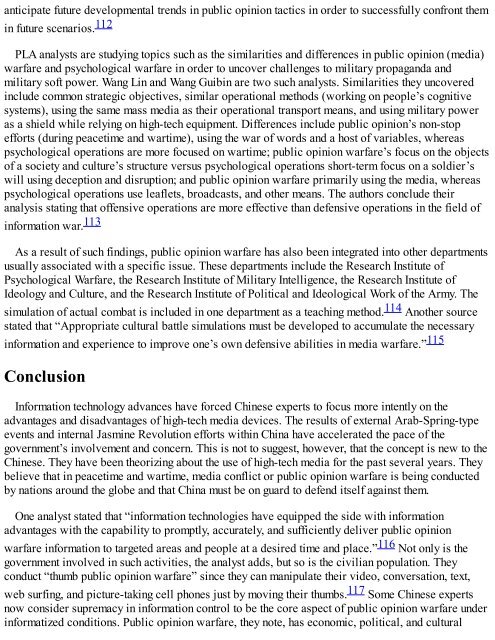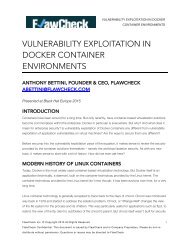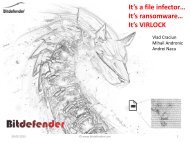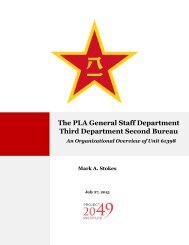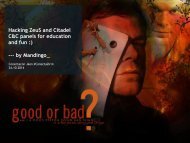3Faces%20of%20the%20Dragon
3Faces%20of%20the%20Dragon
3Faces%20of%20the%20Dragon
Create successful ePaper yourself
Turn your PDF publications into a flip-book with our unique Google optimized e-Paper software.
anticipate future developmental trends in public opinion tactics in order to successfully confront them<br />
in future scenarios. 112<br />
PLA analysts are studying topics such as the similarities and differences in public opinion (media)<br />
warfare and psychological warfare in order to uncover challenges to military propaganda and<br />
military soft power. Wang Lin and Wang Guibin are two such analysts. Similarities they uncovered<br />
include common strategic objectives, similar operational methods (working on people’s cognitive<br />
systems), using the same mass media as their operational transport means, and using military power<br />
as a shield while relying on high-tech equipment. Differences include public opinion’s non-stop<br />
efforts (during peacetime and wartime), using the war of words and a host of variables, whereas<br />
psychological operations are more focused on wartime; public opinion warfare’s focus on the objects<br />
of a society and culture’s structure versus psychological operations short-term focus on a soldier’s<br />
will using deception and disruption; and public opinion warfare primarily using the media, whereas<br />
psychological operations use leaflets, broadcasts, and other means. The authors conclude their<br />
analysis stating that offensive operations are more effective than defensive operations in the field of<br />
information war. 113<br />
As a result of such findings, public opinion warfare has also been integrated into other departments<br />
usually associated with a specific issue. These departments include the Research Institute of<br />
Psychological Warfare, the Research Institute of Military Intelligence, the Research Institute of<br />
Ideology and Culture, and the Research Institute of Political and Ideological Work of the Army. The<br />
simulation of actual combat is included in one department as a teaching method. 114 Another source<br />
stated that “Appropriate cultural battle simulations must be developed to accumulate the necessary<br />
information and experience to improve one’s own defensive abilities in media warfare.” 115<br />
Conclusion<br />
Information technology advances have forced Chinese experts to focus more intently on the<br />
advantages and disadvantages of high-tech media devices. The results of external Arab-Spring-type<br />
events and internal Jasmine Revolution efforts within China have accelerated the pace of the<br />
government’s involvement and concern. This is not to suggest, however, that the concept is new to the<br />
Chinese. They have been theorizing about the use of high-tech media for the past several years. They<br />
believe that in peacetime and wartime, media conflict or public opinion warfare is being conducted<br />
by nations around the globe and that China must be on guard to defend itself against them.<br />
One analyst stated that “information technologies have equipped the side with information<br />
advantages with the capability to promptly, accurately, and sufficiently deliver public opinion<br />
warfare information to targeted areas and people at a desired time and place.” 116 Not only is the<br />
government involved in such activities, the analyst adds, but so is the civilian population. They<br />
conduct “thumb public opinion warfare” since they can manipulate their video, conversation, text,<br />
web surfing, and picture-taking cell phones just by moving their thumbs. 117 Some Chinese experts<br />
now consider supremacy in information control to be the core aspect of public opinion warfare under<br />
informatized conditions. Public opinion warfare, they note, has economic, political, and cultural


